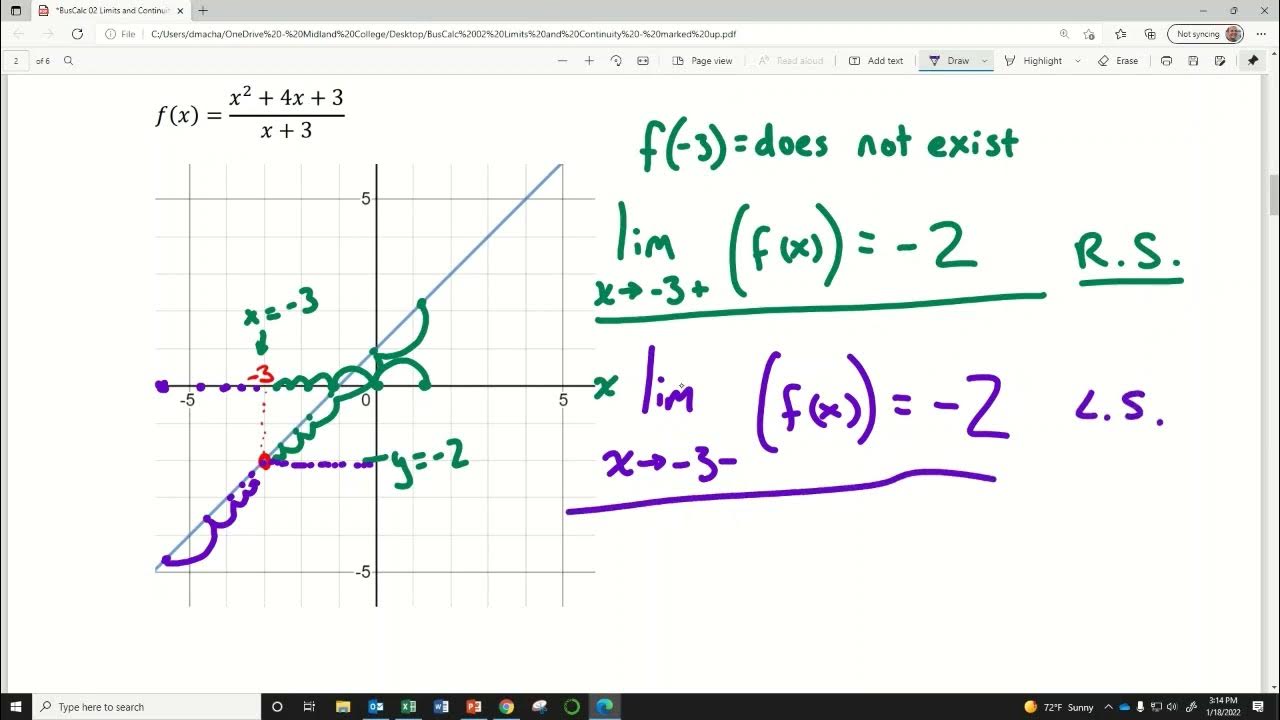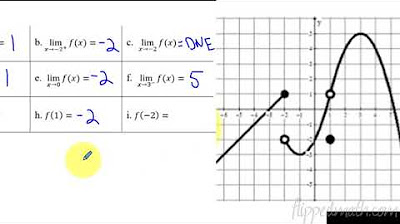Find Limits from Graphs | Calculus 1
TLDRThe video explains how to analyze limits and function values using a graph of a complex function. It covers how to determine if a function's value exists at a given point, how to evaluate one-sided and two-sided limits, and what it means when limits do not exist. Several examples are discussed, including cases where the function value or limit does not exist, or where limits are infinite. The video concludes with a practice exercise and emphasizes the importance of understanding these concepts for studying calculus.
Takeaways
- 🧠 Understanding limits and function values is crucial in studying calculus.
- 🔍 At x = -2, the function does not have a value, as indicated by the vertical asymptote.
- 🔄 The limit as x approaches -2 differs from the left (negative infinity) and the right (positive infinity), so the two-sided limit does not exist.
- ⚠️ For x = 0, the function's value is 4, as shown by the filled circle, but the two-sided limit does not exist due to differing one-sided limits.
- 🚫 At x = 2, the function does not have a value, and the two-sided limit is 1/2 since both one-sided limits are equal.
- ✅ At x = 4, the function's value is 2, and the two-sided limit is positive infinity, as both one-sided limits approach infinity.
- 📊 The script highlights scenarios where the function's value and the limit either exist or don't, explaining how to identify each.
- 💡 The limit of a function is independent of its actual value at that point; it only depends on the behavior as it approaches the point.
- ❌ One-sided limits must be equal for a two-sided limit to exist; if they differ, the two-sided limit does not exist.
- 📝 Exercises like these are essential for mastering the concepts of limits and function values in calculus.
Q & A
What is the function value at x = -2 according to the graph?
-The function does not have a value at x = -2 because there is no point on the graph at that x-coordinate. Instead, there's a vertical asymptote, meaning x = -2 is not in the function's domain.
Why does the two-sided limit of the function as x approaches -2 not exist?
-The two-sided limit does not exist because the one-sided limits are not equal. As x approaches -2 from the left, the function approaches negative infinity, while from the right, it approaches positive infinity.
What is the function's value at x = 0?
-The function's value at x = 0 is 4, indicated by the filled-in circle on the graph.
Why does the two-sided limit as x approaches 0 not exist?
-The two-sided limit as x approaches 0 does not exist because the one-sided limits are not equal. From the right, the limit is 4, while from the left, it is 1/2.
What is the function's value at x = 2?
-The function does not have a value at x = 2, as indicated by the open circle on the graph. This means x = 2 is not in the function's domain.
What is the two-sided limit as x approaches 2?
-The two-sided limit as x approaches 2 is 1/2. Both the left and right one-sided limits are equal to 1/2.
What is the function's value at x = 4?
-The function's value at x = 4 is 2, as indicated by the filled-in dot on the graph.
What is the two-sided limit as x approaches 4?
-The two-sided limit as x approaches 4 is positive infinity, as both one-sided limits approach positive infinity.
Can the function have a limit if it does not have a value at a certain x-coordinate?
-Yes, the function can have a limit at an x-coordinate even if it does not have a value there. For example, the limit as x approaches 2 exists even though the function does not have a value at x = 2.
Why is it important to consider one-sided limits when evaluating two-sided limits?
-It is important to consider one-sided limits because a two-sided limit only exists if the one-sided limits from both directions are equal. If they differ, the two-sided limit does not exist.
Outlines
📈 Introduction to Limits and Function Values
The video discusses examples of finding limits and function values on a graph of a complex function. It emphasizes the importance of understanding functions and limits for calculus studies and suggests practicing exercises to improve comprehension. The first example involves identifying the function's value at x = -2, which does not exist due to a vertical asymptote.
🔍 Analyzing Limits at x = -2
The function's value at x = -2 is non-existent, but the limit as x approaches -2 needs to be evaluated. This involves examining one-sided limits: from the left, the function approaches negative infinity, and from the right, it approaches positive infinity. Since the one-sided limits are unequal, the two-sided limit does not exist.
🧐 Function Value and Limits at x = 0
For x = 0, the function's value is 4, indicated by a filled-in circle. The limit as x approaches 0 involves one-sided limits: from the right, the function approaches 4, and from the left, it approaches 0.5. The unequal one-sided limits mean the two-sided limit does not exist.
🚫 Function Value and Limits at x = 2
At x = 2, the function has no value due to an open circle. Evaluating the limit as x approaches 2, both one-sided limits (from the left and right) are 0.5, indicating that the two-sided limit is also 0.5, despite the function's value not existing at x = 2.
📊 Function Value and Limits at x = 4
For x = 4, the function's value is 2, indicated by a filled-in dot. The limit as x approaches 4 involves examining one-sided limits: from both directions, the function approaches positive infinity. Since the one-sided limits are equal and infinite, the two-sided limit is positive infinity.
🧪 Example Problem and Conclusion
The final example problem involves finding the function's value and limit at x = 1 and x = 4. At x = 1, the function's value is 2, but the limit does not exist due to unequal one-sided limits. At x = 4, the function's value does not exist, but the two-sided limit is 2. The video concludes by summarizing the different scenarios of function values and limits discussed.
Mindmap
Keywords
💡Limit
💡Function
💡Asymptote
💡Domain
💡Two-sided Limit
💡One-sided Limit
💡Open Circle
💡Filled Circle
💡Positive Infinity
💡Negative Infinity
Highlights
Understanding functions and limits is crucial for calculus students.
At x = -2, the function does not have a value due to a vertical asymptote.
The two-sided limit as x approaches -2 does not exist because the left-sided limit is negative infinity and the right-sided limit is positive infinity.
At x = 0, the function's value is 4, indicated by a filled-in circle on the graph.
The two-sided limit as x approaches 0 does not exist because the left-sided limit is 0.5, and the right-sided limit is 4.
At x = 2, the function does not have a value due to an open circle on the graph.
The two-sided limit as x approaches 2 is 0.5, as both the left and right-sided limits are equal.
At x = 4, the function's value is 2, indicated by a filled-in dot on the graph.
The two-sided limit as x approaches 4 is positive infinity because both the left and right-sided limits approach infinity.
The transcript covers multiple cases where either the function's value or the limit, or both, do not exist.
Examples include cases where the limit exists but the function's value does not, and vice versa.
The transcript provides a step-by-step analysis of evaluating limits from both sides of a given point.
One-sided limits are essential for determining the existence of two-sided limits.
The final exercise emphasizes understanding the difference between a function's value and its limit at a specific point.
The speaker encourages practice and repeated review for mastering the concepts discussed.
Transcripts
Browse More Related Video

How To Evaluate Limits From a Graph

BusCalc 02 Limits and Continuity

Calculus AB/BC – 1.3 Estimating Limit Values from Graphs

Calculus - One Sided Limits

Business Calculus - Math 1329 - Section 1.5 (Part 1) - Limits and Continuity

One-sided limits from graphs | Limits | Differential Calculus | Khan Academy
5.0 / 5 (0 votes)
Thanks for rating: